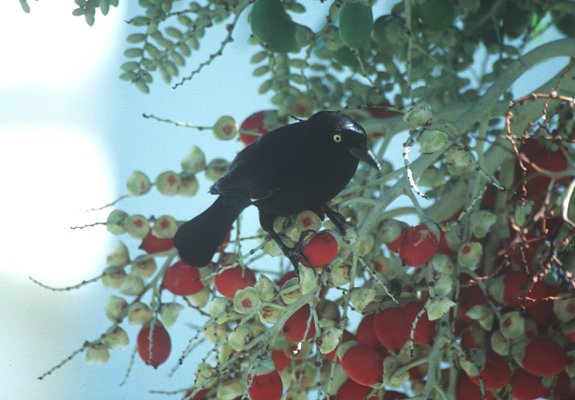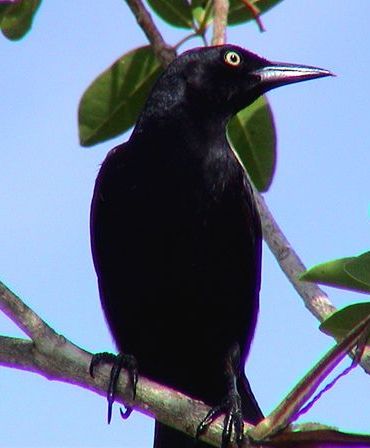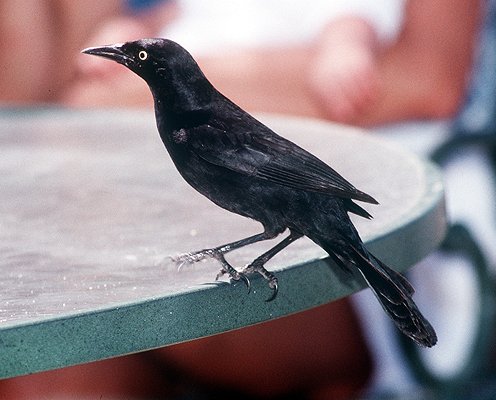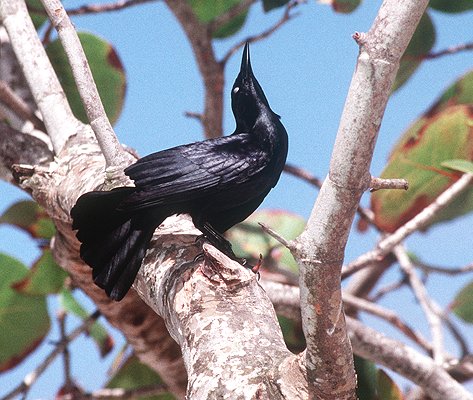|
Greater Antillean Grackle Quiscalus niger Mozambique, Chango, |
 |
|
Photo: M. Oberle
|
|
Greater Antillean Grackle Quiscalus niger Mozambique, Chango, |
 |
|
Photo: M. Oberle
|
|
IDENTIFICATION: An iridescent black bird with a long, narrow bill, long tail, and bright yellow eyes. The female is smaller and less iridescent than the male. Juvenile birds have brown eyes. Some rare individuals have varying amounts of white body feathers. Length: 25-30 cm.; weight: males 87 g., females 65 g. VOICE: A variety of whistles and clucking call notes; a thin high "tee tee tee." When displaying on the ground or along a palm leaf or other perch, it throws its head back and points its bill to the sky. It also has a "ruff out" display (see photo) in which it fluffs its feathers and sings, while spreading its wings and tail. It also has a common call note, "chuck." Audio 4 (M. Oberle). HABITAT: Farms, open country and towns; avoids deep forest. HABITS: Boldly walks on the ground looking for food in fields, gardens, stream banks, and even parking lots and open air restaurants. The grackle often holds its outer tail feathers higher than the central tail feathers. This results in a "V"-shaped appearance to the tail when viewed from in front or behind. It eats fruits, nectar, seeds, ticks, frogs, lizards, snails, and discarded human food including bread, French fries, beans, and meat scraps. But most of the diet consists of insects, such as crickets, grasshoppers, roaches, weevils, and caterpillars. It sometimes raids other birds’ nests. The grackle roosts in large noisy flocks at night in a protected tree, such as in town plazas. It nests in loose colonies in the tops of trees, palms, or even electrical power substations. The female makes a cup-shaped nest of grasses and sticks combined with artificial materials such as paper, plastic, wire, straws, and mop strings. She lays 3-5 bluish or olive eggs with red or black speckles. The young fledge about 23 days after hatching. This species is easily attracted to bird feeders, and gangs up to exclude other species from prime feeding spots. STATUS AND CONSERVATION: A common bird of towns and open country, especially in lowland Puerto Rico. Grackle chicks in nests that have been parasitized by Shiny Cowbirds have a lower growth rate than grackle chicks in nests without cowbird chicks. But the female grackle will often eject cowbird eggs. RANGE: As its name implies, the Greater Antillean Grackle occurs only in the Greater Antilles. TAXONOMY: PASSERIFORMES; ICTERIDAE. There are seven subspecies of this bird. The endemic Puerto Rican subspecies (Quiscalus niger brachypterus) is larger than the subspecies on Hispaniola. Five related species occur elsewhere in the Americas. |
 |
|
Photo: G. Beaton
|
 |
|
Photo: R. Rodríguez Mojica
|
 |
|
Photo: M. Oberle
|
 |
|
Photo: M. Oberle
|
 |
|
Photo: M. Oberle
|
|
References Jaramillo A. and P. Burke. 1999. New World Blackbirds: The Icterids. Princeton Univ Press. Pérez-Rivera, R. A. 2000. Alimentos y conducta alimentaria no informadas en el Mozambique (Quiscalus niger brachipterus) de Puerto Rico. El Pitirre 13(2):40-41. Post, W., T.K. Nakamura, and A. Cruz. 1990. Patterns of shiny cowbird parasitism in St. Lucia and Southwestern Puerto Rico. Condor 92:461-469. Raffaele, H.A. 1989. A guide to the birds of Puerto Rico and the Virgin Islands. Princeton. Raffaele, H.A. 1989. Una guía a las aves de Puerto Rico y las Islas Vírgenes. Publishing Resources, Inc., Santurce, PR. Raffaele, H.A., J.W. Wiley, O.H. Garrido, A.R. Keith, and J.I. Raffaele. 1998. Guide to the birds of the West Indies. Princeton. Wiley, J.W. 1985. Shiny Cowbird parasitism in two avian communities in Puerto Rico. Condor 87:165-176. Wiley, J.W. 1986. Growth of Shiny Cowbird and host chicks. Wilson Bull. 98:126-131. Greater Antillean Grackle, Spanish text Next related species in taxonomic order Previous related species in taxonomic order |